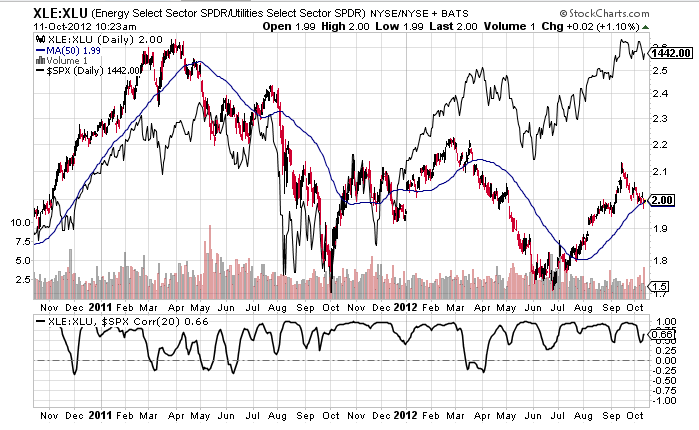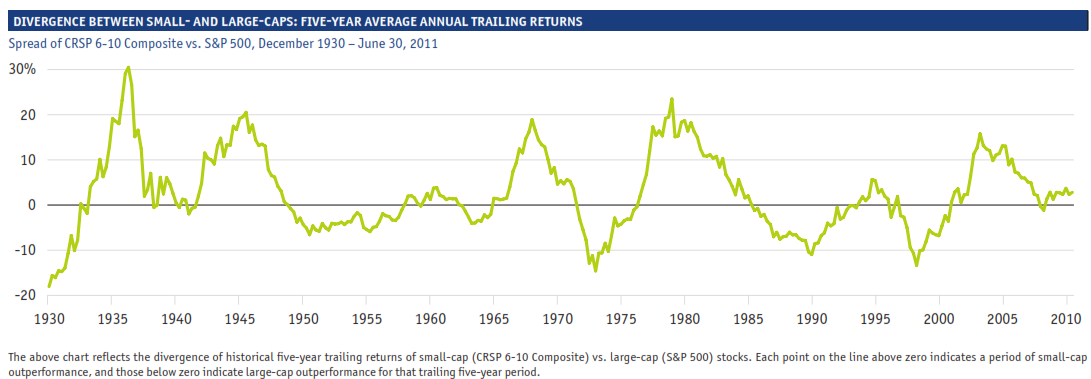The U.S. stock market still has room to rally, says investment manager Matt Pierce at Island Light Capital, although he’s recently bought more lower-volatility stocks in his Covestor models in an effort to reduce risk.
“We started it in the beginning of September for all models, taking away from some of the volatile growth groups and adding the low-volatility plays, he says. “They typically are utilities, consumer staples, and the traditionally defensive asset classes.”
In all three models — even his Growth Portfolio, Pierce purchased the S&P 500 Low Volatility ETF (SPLV), made up of stocks that typically have a lower beta — or volatility level — than the market as a whole.

Source: Stockcharts.com
He might not be alone. One reason to think that other equity investors began to broadly dial back risk in mid-September is reflected in the chart above.
In red and black is the Energy Select Sector SPDR (XLE), relative to the Utilities Select Sector SPDR (XLU). It tends to work as a market risk indicator that often moves in line with the S&P 500 (SPX) (note the correlation at the bottom of the chart).
Here’s why this is a potentially useful risk gauge: Energy has long been considered a cyclical stock sector that rallies when investors want more exposure to a potentially improving economy. Conversely, utilities are considered a defensive, or non-cyclical stock group that is less economically sensitive. Utilities may lag in market rallies, but most offer less volatility and typically higher dividends than the market at large.
Looking at the XLE/XLU, therefore, can provide insights on investors’ risk-taking mood, and it may even provide clues about future market movements. Notice in the chart that the XLE/XLU began to fall ahead of the S&P 500 in both July 2011 and March 2012.
The overall market risk-taking is lower, but it has not fallen dramatically, says Pierce. The biggest worry, he says, is the fiscal cliff — the combination of tax hikes and automatic spending cuts that are scheduled to go into effect next year, unless the U.S. Congress comes to an agreement to extend Bush-era tax cuts and on new potential new budget rules.
Pierce still believes that something will be worked out, and that there are potential gains ahead.
“I cannot believe that whoever wins the election will not do something about it, even with a lame duck Congress,” Pierce says. “It might not be a perfect fix, but I suspect that they will at minimum kick the tax policy down the road so there will not be a huge GDP hit.”
Such a scenario calls for continued market exposure, according to Pierce, although with a higher degree of caution and careful stock selection.
The index comparisons herein are provided for informational purposes only and should not be used as the basis for making an investment decision. There are significant differences between client accounts and the indices referenced including, but not limited to, risk profile, liquidity, volatility and asset composition. The S&P 500 is an index of 500 stocks chosen for market size, liquidity and industry, among other factors. The investments discussed are held in client accounts as of September 30, 2012. These investments may or may not be currently held in client accounts.The reader should not assume that any investments identified were or will be profitable or that any investment recommendations or that investment decisions we make in the future will be profitable. Certain of the information contained in this presentation is based upon forward-looking statements, information and opinions, including descriptions of anticipated market changes and expectations of future activity. Covestor believes that such statements, information, and opinions are based upon reasonable estimates and assumptions. However, forward-looking statements, information and opinions are inherently uncertain and actual events or results may differ materially from those reflected in the forward-looking statements. Therefore, undue reliance should not be placed on such forward-looking statements, information and opinions.


